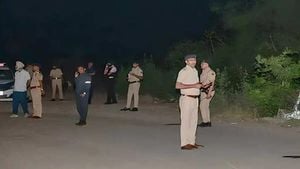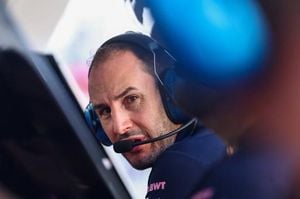The ongoing conflict between Russia and Ukraine has reached new heights as the Russian Ministry of Defense reported an unprecedented interception of over 500 Ukrainian drones in just one day. This surge in drone activity coincides with the approach of Russia's Victory Day celebrations, a significant event marking the 80th anniversary of the end of World War II in Europe. Experts are raising alarms about the growing reliance on drone warfare and the need for enhanced defense systems to counteract this evolving threat.
According to the Ministry of Defense, Russian air defense systems successfully shot down 524 drones launched by Ukrainian forces on May 6, 2025. This figure represents a record number of interceptions since the beginning of the special military operation. In addition to the drones, Russian forces also destroyed two rockets from the American HIMARS multiple launch rocket system, six JDAM guided bombs, and five Ukrainian Neptune missiles during the same period.
Former head of the anti-aircraft missile forces of the Russian Aerospace Forces, Sergey Khatylev, linked the increase in drone attacks to the upcoming Victory Day celebrations. He suggested that Ukraine is attempting to disrupt the festivities on Red Square by launching these attacks. Khatylev stated, "Vladimir Zelensky is trying to prevent the heads of state, who are invited as guests to the parade, from arriving. He is proving to his Western sponsors that he can take action. President Vladimir Putin has clearly stated that this is no longer a military operation but terrorism. Zelensky, like a terrorist, threatens not only Russia but also other countries."
The recent drone attacks have targeted various regions across Russia, including Moscow and its suburbs, as well as Tula, Voronezh, Yaroslavl, and Kostroma. On the night of May 6, Ukrainian forces launched an attack involving 105 drones, with 19 intercepted over Moscow and the surrounding area. Later that evening, Moscow Mayor Sergey Sobyanin announced the interception of eight more enemy drones. The following day, May 7, reports indicated that Moscow and several other regions were again subjected to drone attacks, prompting Sobyanin to report the interception of seven drones heading toward the capital. Just two hours later, two additional UAVs were destroyed, leading to a temporary suspension of flight operations at the capital's airports.
Military experts have identified the types of drones used in these attacks. Reports suggest that the Ukrainian forces employed 'Lyutyi' drones, which can travel up to 1000 kilometers and carry warheads weighing up to 50 kilograms. These drones are designed to operate in swarms, making them particularly challenging to intercept. However, the Russian Ministry of Defense has not confirmed the specific use of 'Lyutyi' drones in these recent assaults.
Vladislav Shurygin, a military expert, speculated that the drones are likely being launched from Ukrainian territory, aided by Western allies who provide access to electronic maps and intelligence on Russian air defense positions. Shurygin noted, "There is a significant amount of assistance from Western allies, who give Ukrainians access to electronic maps. It is quite possible that their intelligence about the location of our air defense systems is being passed to the Ukrainian Armed Forces so they can plot routes to bypass these positions."
Furthermore, Khatylev highlighted the potential involvement of 'sleeper cells' of Ukrainian supporters within Russia, who might be assisting in launching drones from Russian territory. He explained, "There are UAVs of aircraft type, in the characteristics of which the possibility of flying up to 2000 km is embedded. They are launched from Ukrainian territory. The FSB and other agencies are aware that launches of certain types of drones are occurring from Russian territory. These could be carried out by reconnaissance and sabotage groups in border areas, and people are paid to perform these tasks."
The increasing frequency and sophistication of drone attacks have raised concerns about the effectiveness of Russia's air defense systems. Khatylev emphasized the need for a new weapons system and improved training for combat crews, stating, "UAVs have become a major problem, not only for Russia. This is a special aerial target that requires specific efforts—not only from the air defense system but also from other structures. A new weapons system, principles, methods, and enhanced training of combat crews based on existing experience of the special military operation are necessary."
As the conflict continues, the implications of drone warfare are becoming increasingly evident. The ability of Ukraine to launch coordinated drone strikes deep into Russian territory showcases the changing dynamics of modern warfare. With the upcoming Victory Day celebrations, the stakes are higher than ever, and both sides are on high alert.
In summary, the recent surge in drone attacks by the Ukrainian Armed Forces has prompted a significant response from Russian air defense systems. The interception of over 500 drones in a single day marks a record high, highlighting the ongoing challenges faced by Russia in countering this evolving threat. As both nations prepare for a potentially tense period surrounding Victory Day, the need for advanced defense strategies and international support remains critical.



